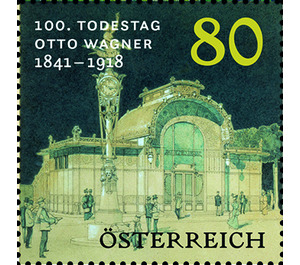100th anniversary of the death of Wagner - Austria / II. Republic of Austria 2018 - 80 Euro Cent
Theme: Architecture
| Country | Austria / II. Republic of Austria |
| Issue Date | 2018 |
| Face Value | 80.00 |
| Edition Issued | 160,000 |
| Perforation | 13¾ x 13¾ |
| Printing Type | offset |
| Stamp Type | Commemorative |
| Item Type | Stamp |
| SID | 637181 |
| Dimensions | 35.00 x 35.00 |
| In 37 Wishlists | |
Four-horse-drawn passenger coach on the Tauern mountain road Mail coach from the Tauern region The design for this year’s issue from the “Historical postal vehicles” series, which has now been running for five years, shows a passenger mail coach at the top of the pass on the Tauern mountain road. In addition to the mail, the four-horse-drawn coach is also carrying passengers and their luggage, which is strapped to the roof. The coach appears to be travelling at high speed; the road looks to be exceptionally firm and well-used. The coachman, hidden beneath the protruding roof at the front of the carriage is barely visible. Carrying the post over the Tauern Mountains The route over the Radstadt Tauernstraße and the Tauern Pass connects Pongau in the Salzburg region with Lungau. The route was already used by the Celts and was one of the few easily traversable passes over the Alps. During the Roman era the Tauernstraße was one of the main transport routes and there was a station known as “In Alpe” at the top of the pass, where the horses could be changed. This station probably stood roughly on the site of what is now the Tauern cemetery, which was consecrated in 1515. On the block of stamps, the walled Tauern cemetery can be seen in the background with the small chapel that the coach is just passing. In the Middle Ages “Tauernhäuser” provided rest and accommodation for travellers. Prince Bishop Sigismund Graf Schrattenbach had the Untertauern postal station built in the mid-18th century. The mail coach now routinely travelled along the Tauernstraße twice a week. During the 19th century the frequency was increased, and from 1885 onwards, it traversed the Tauernpass daily. The former postal station subsequently became the post and telegraph office, and now houses the “Gasthof zur Post”. For a long time the mail coach constituted the only means of transporting passengers other than private horse-drawn vehicles. Like the transportation of letters and parcels, this passenger service was subject to the postal monopoly; the routes, prices and departure times were listed in the postal directory. Significant roads were raised to the category of “postal roads”, the condition of which was monitored by the postmasters. It was only with the advent of the railway in the mid-19th century that the passenger service gradually became less important.


